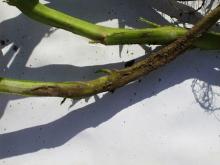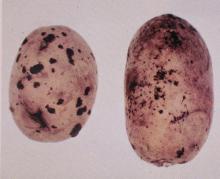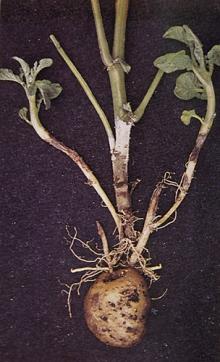By P. B. Hamm and C. M. Ocamb
Cause Rhizoctonia solani, a fungus that is a common soil inhabitant and has a wide host range. Seed pieces can carry the fungus but soilborne inoculum can be equally as damaging.
Symptoms When sprouts are infected before emergence, they may be girdled and killed by reddish to dark brown girdling cankers found on the stems at or below ground. Stems seem to become more resistant to infection once they emerge. If plants are infected later in their development, they may have reddish-brown to brown lesions on stems, stolons, tubers, and roots. Aerial tubers may form on the stem if the fungus has girdled the stem below. Leaf curl, like that caused by the potato leafroll virus, may occur. Tubers may have black bodies (scurf) on the surface and they are not easily removed. While the bodies do not affect the tuber's interior, enough of them on the surface of potatoes being grown for the fresh market will cause rejection.
Cultural control
- Rotate out of potatoes, preferably for 3 years.
- Shallow planting followed by gradual hilling-up speeds emergence and reduces damage.
- Avoid over-irrigating early in the season. Cooling soil with irrigation slows emergence and favors the fungus.
- If possible, avoid seed lots that contain sclerotia.
- Warm seed before planting.
- To encourage more rapid emergence, plant deep but cover with a shallow layer of soil.
- The disease may be more severe when following sugar beets, alfalfa, or clover that was plowed down the spring of planting.
- Delaying planting until soil temperatures warm and soil moisture is drier will reduce infection.
Chemical control
- CruiserMaxx Vibrance Potato (Group 7 + 3 + 12) at 0.5 fl oz/100 lb seed pieces. 12-hr reentry.
- Elatus (Group 11 + 7) at 0.34 to 0.5 oz/1,000 row feet applied in a 7-inches or less band either in-furrow at planting. Preharvest interval is 14 days. 12-hr reentry.
- Evito 480 SC (Group 11) at 0.16 to 0.24 fl oz/1,000 ft row. Do not apply within 7 days of harvest. 12-hr reentry.
- Evolve Potato Seed Piece Treatment (Group 1 + 27 + M3) at 0.75 lb/100 lb seed pieces.
- Headline (Group 11) at 0.4 to 0.8 fl oz/1,000 row feet. Apply spray in-furrow at planting. 12-hr reentry.
- Heads Up at 0.035 oz/34 fl oz water/220 to 582 lb seed pieces will stimulates pest suppression system of plants. Efficacy unknown. 12-hr reentry. O
- Maxim MZ (Group 12) at 0.5 lb/100 lb seed pieces or Maxim 4FS at 0.08 to 0.16 oz/100 lb seed pieces. 12-hr reentry for Maxim 4FS; 24-hr reentry for Maxim MZ
- Moncut 70DF (Group 7) at 0.75 to 1.0 lb/A in-furrow in at least 5 gal water/A. Rotation crop restrictions on label. 12-hr reentry.
- OSO 5% SC (Group 19) at 3.75 to 13 fl oz/A on 7- to 14-day intervals. Can be applied the day of harvest. 4-hr reentry. O
- Quadris Flowable (Group 11) at 0.4 to 0.8 fl oz/1,000 row feet applied in a 7-inches or less band either in-furrow at planting or as a directed spray at cultivation. 4-hr reentry.
- Quadris Ridomil Gold (Group 11 + 4) at 0.82 fl oz/1,000 row feet applied in-furrow using 3 to 15 gal water/A. See label for reentry intervals.
- Regalia (Group P5) at 1 to 4 quarts/A as an in-furrow treatment. Does not benefit from the addition of an adjuvant. 4-hr reentry. O
Biological control
- Amplitude ST at 3.2 to 4.8 fl oz/100 lb seed pieces. 4-hr reentry. O
- Double Nickel LC at 1 to 2 quarts/A as a banded soil spray or drench on 4- to 6-week intervals or at 0.5 to 4.5 pints/A on 2- to 4-week intervals. Can be applied the day of harvest. 4-hr reentry. O
- Stargus at 6 to 8 fl oz per 1,000 ft row as an in-furrow treatment, 3 to 4 quarts/A as a soil drench on 10- to 14-day intervals, or 3 to 4 quarts/A as a chemigation drip treatment on 14- to 21-day intervals. Preharvest interval is 0 days. 4-hr reentry. O



